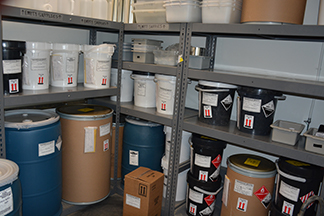5 Things to Consider When Setting Up Your Hazardous Waste Room
 In the world of environmental health and safety, we are accustomed to constant change and fluctuation. Many of us at some point in our careers have been part of a company that has either expanded or moved spaces to accommodate changes needed for functional workspaces. The expectation from leadership is to make these moves as economically and compliantly as possible.
In the world of environmental health and safety, we are accustomed to constant change and fluctuation. Many of us at some point in our careers have been part of a company that has either expanded or moved spaces to accommodate changes needed for functional workspaces. The expectation from leadership is to make these moves as economically and compliantly as possible.
This can make the situation hectic, as managing these transitions are often piled onto an already “at capacity” workload. One thing that typically falls to the bottom of the priority list during these changes is the Hazardous Waste program, particularly the details around setting up an adequate Hazardous Waste storage room that will maintain program efficiency well beyond the initial installation. It’s often difficult to think months or years down the road when so much emphasis on project-based costs and timelines are driven by leadership. Taking time to assess these 5 items will create long-term program success and maximize waste stream efficiency. The pain/gain curve is well worth the initial effort and will help eliminate costly retroactive program adjustments and chronic inefficiencies.
Whether you're moving into a new space or building out and expanding your current space, here are 5 things to consider when setting up your Hazardous Waste Room.
- Size and Scalability: If you are moving into new space, chances are you are growing as a company. With company growth comes increased chemical use and in turn increased chemical waste production. When identifying new space for a waste room it is important to consider the scalability of the space to ensure the waste room can handle increased future waste production.
- Physical Location: Flammable or reactive waste must be kept 15 meters from the facility property line. Waste rooms are often exiled to the outskirts of facilities into more “undesirable” spaces. Be cautious of how close to your neighbors you set up this space. Try to set up near your loading dock if possible, which can save a lot of time and resources during waste shipments. Additionally, the less time spent handling and transferring hazardous waste, the safer the shipment process becomes.
- Waste Streams: It is important to understand what type of waste will be collected in this new space and how it will be collected. Safety, logistical, and economic considerations must be made while evaluating your new waste room; however this is all very dependent on the hazardous characteristics of the waste that will be produced and collected.
- Ventilation: High ventilation capabilities are highly recommended for hazardous waste storage rooms. Having the capability to install walk-in hoods for waste storage and consolidations is recommended. If you are consolidating material in the waste room, air monitoring should be performed to assess the proper personal protective equipment needed.
- Intrinsically Safe: Take care to assess the regulations for flammable and reactive wastes to make sure your hazardous waste storage is prepared for all types of waste. Depending on your particular situation you may be required to make your waste room intrinsically safe.
Want to learn more about how we can help you manage your hazardous waste? Contact our experts.







